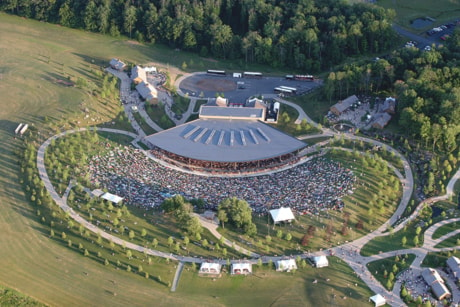BETHEL, N.Y. — With a psychedelic Chevy bus as a backdrop, Wade Lawrence is trying to talk the shirt off a man’s back.
It’s not just any shirt. It’s an original Woodstock T-shirt, and there were no T-shirts or any other merchandise sold at the legendary festival just another way the organizers lost money.
The only people with Woodstock T-shirts were crew members, which is how this current roadie for the Doobie Brothers got his faded purple T with the dove logo.
“It’s only the second one I’ve seen,” said Lawrence, director of The Museum at Bethel Woods (aka the Woodstock Museum).
The crew member got away still wearing the shirt, as Lawrence didn’t really have anything to offer him but a smile and a glass case of immortality.
“We don’t have an acquisitions budget,” Lawrence says. “When we see things like that, we just ask people to leave it to us in their will.”
The museum opened in June 2008. It’s one piece of the $100 million Bethel Woods Center for the Arts, set in the lush, green Catskills on a hillside above the original Woodstock site.
The facility also includes a beautiful and somehow cozy 15,000-capacity amphitheater, which recently held concerts by the likes of Dave Matthews and Bob Dylan.
On Aug. 14 and 15, the centre will mark the original event with Richie Havens and a Heroes of Woodstock concert with the Levon Helm Band, Jefferson Starship, Ten Years After, Canned Heat, Big Brother and the Holding Company, Mountain, former Grateful Dead keyboardist Tom Constanten and Country Joe McDonald.
The Bethel Center was the baby of a Bethel Woods Republican and former Marine, Alan Gerry, who became a billionaire through cable TV. He forbade his daughters to attend the 1969 festival, but one slipped off and went anyway.
Looking to inject economic life into the struggling community, Gerry’s foundation funded the facility to the tune of $85 million, and the rest came from New York taxpayers. (The $1 million requested and not granted in federal funds became a political football during a debate between then-Sen. Hillary Rodham Clinton, D-N.Y., and Sen. John McCain, R-Ariz.)
Those expecting to find a little room housing photos and artifacts will be surprised and delighted by a monument that’s smaller but in many ways cooler than Cleveland’s Rock and Roll Hall of Fame.
The museum sets the stage for Woodstock with a glimpse into the culture, fashion and politics of the ’50s and early ’60s, using record covers, a time line along the wall and vintage video clips.
The festival’s convoluted planning is documented, from the original idea of a recording studio in Woodstock to the full-blown event on Max Yasgur’s farm, and then visitors can plop down on beanbag chairs in a theatre-in-the-round to watch a short concert film with theatrical lighting accenting the sunshine and thunderstorms.
The best part is climbing aboard the aforementioned Chevy bus for a film projected on the windshield about the road to Woodstock.
Among the artifacts scattered about are host Wavy Gravy’s tattered overalls, photos and news articles about the festival, and handwritten notes Woodstockers wrote to each other during the weekend. (Note to parents: It’s almost like the drugs and nudity didn’t happen.)
The final stops are a computer kiosk where visitors can leave messages and a barn theater where the sounds of Santana, Joe Cocker, The Who, Hendrix and others can finally be cranked at proper volume.
Just a few steps from the museum is the entrance to the amphitheater, which has a woodsy feel. Parking is (amazingly) free and the venue has more of a laidback rural quality with parklike landscaping and relaxed security. The covered pavilion makes the performers appear bigger than stick figures from the lawn.
A popular living artifact at the facility is 66-year-old Duke Devlin, who hitchhiked to the festival from Texas and never left.
“I didn’t plan on staying,” says Devlin, who sports long gray hair and beard and a Woodstock tattoo. “I landed a job on a dairy farm, was going to make some money to get back. The next thing I knew, it was November and the snow was starting to fly, and I think I had about five or six invitations to Thanksgiving dinner. I made a lot of friends around there because this area is noted for its beauty and hospitality . . . well, the content of the people is just as beautiful. I met a girl and we got married.”
For 30 years, they ran a farmers market, which they recently sold.
Devlin now spends a few days a week at the museum as a “site interpreter” to make people’s visits more authentic.
“The Gerry Foundation was putting together the museum,” he says, “and I’m like one of those old retired Dalmation fire dogs when the bell rings he still comes running.”
Devlin says he doesn’t think of the centre as a museum.
“I call it a time machine. You didn’t even have to be at the original event. As a matter of fact, you didn’t have to be born yet to go in that museum and make a trip back to Woodstock.”
As for the amphitheater, he loves what it’s done for the local economy and the sound of music at Woodstock is a magical thing.
“A guy from The New York Times said to me, ‘Hey Duke, are you going to see the New York Philharmonic? I said, ‘No, man. They’re comin’ to see me.”’
